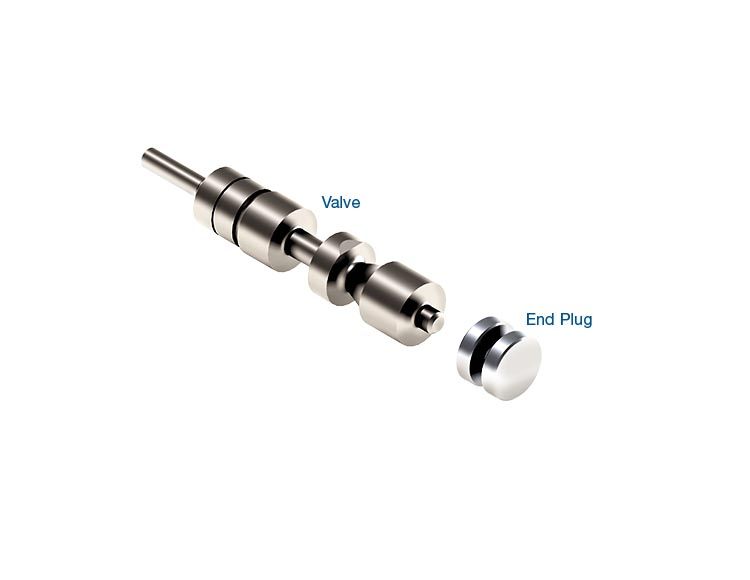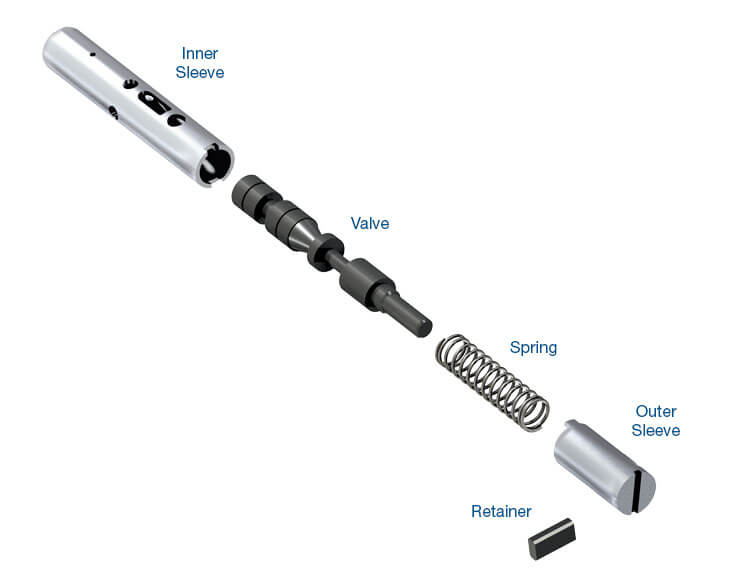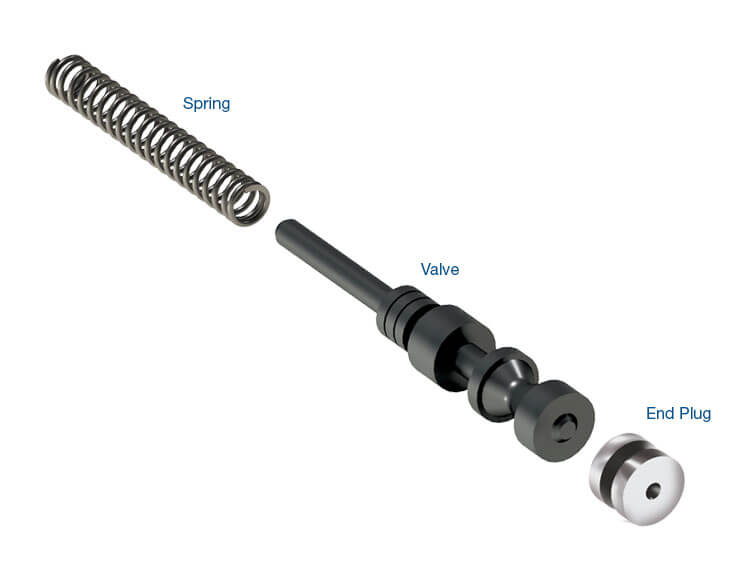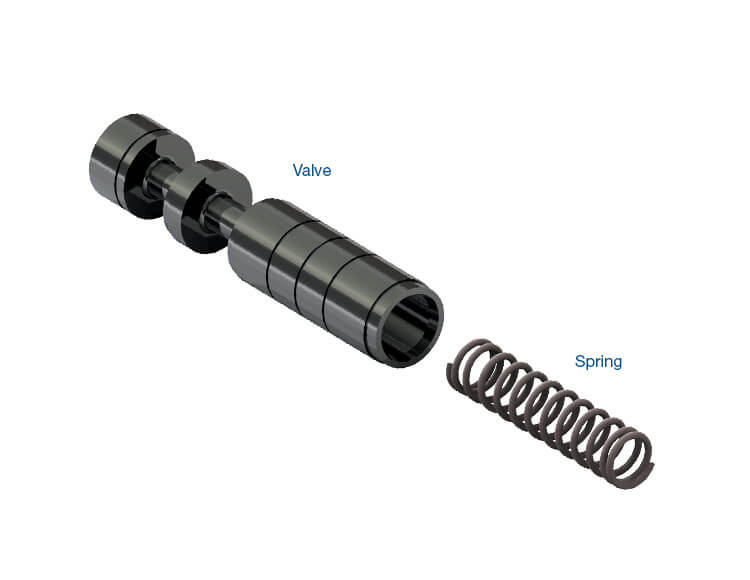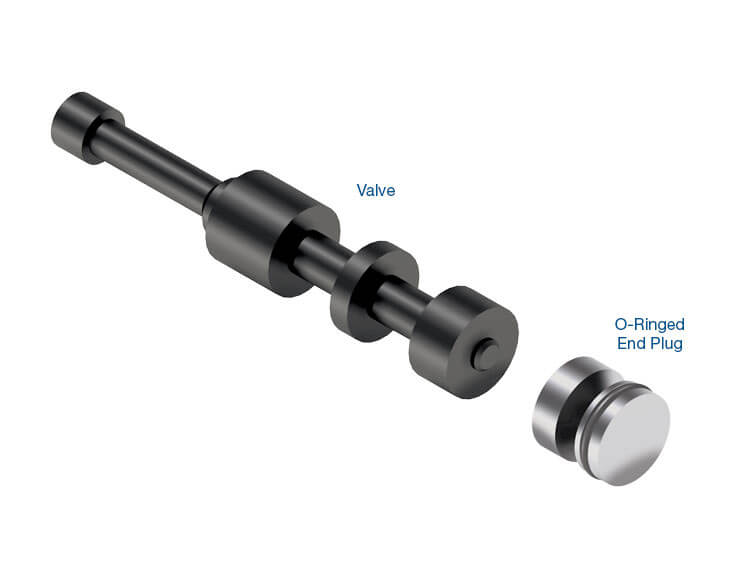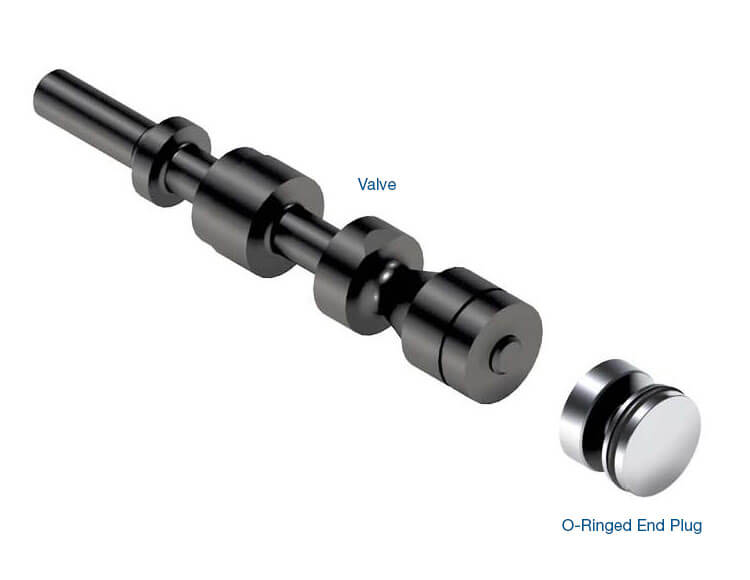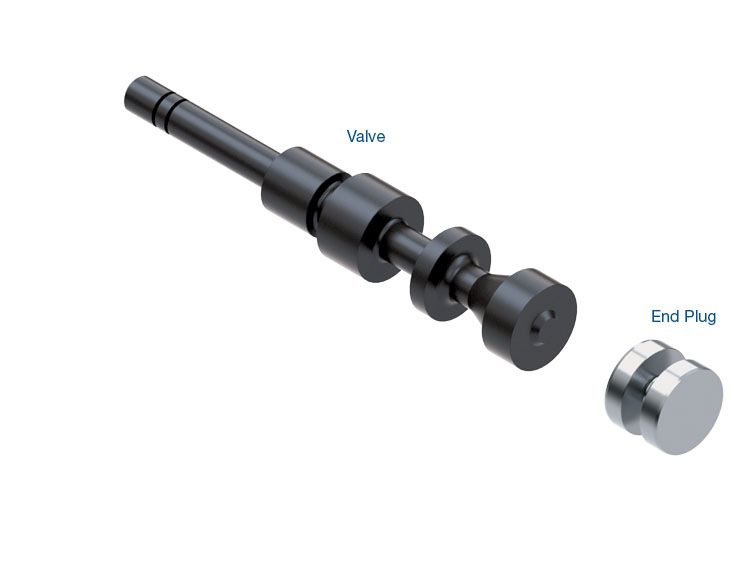November 20, 2020
Hydraulics Fundamentals Part III: Secondary Regulators
Jim Dial
Read Part I and Part II of the Hydraulics Fundamentals series.
The secondary regulator valve is primarily used in Aisin AW variations, including Toyota/Lexus U140, U150, U660, U760, A760, A761, A960, AB60 and VW/Audi 09G and 09D, just to name some current applications.
This valve has been around for a long time, even back to the old A40 non-lockup models. The secondary regulator valve controls torque converter release and apply pressure, as well as lubrication pressure and balance pressure. It basically limits these pressures to approximately 100 and 120 psi, depending on vehicle application. This prevents TCC release and apply timing issues, as these circuits are controlled to a maximum pressure.
Looking back at other OE transmission applications, some manufacturers use a torque converter limit valve on the release side of the torque converter circuit and then use regulated line pressure to apply the clutch. Other OE applications will have a TC limit valve on the release side and a TC regulator valve on the apply side of the torque converter clutch circuit. The use of the secondary regulator valve basically handles both release and apply pressures through one valve in the Aisin family. Figure 1 shows a partial oil circuit diagram of the secondary regulator valve on the U760 and its connection to the primary regulator valve.
| Figure 1 – U760 Partial Circuit Diagram |
|---|
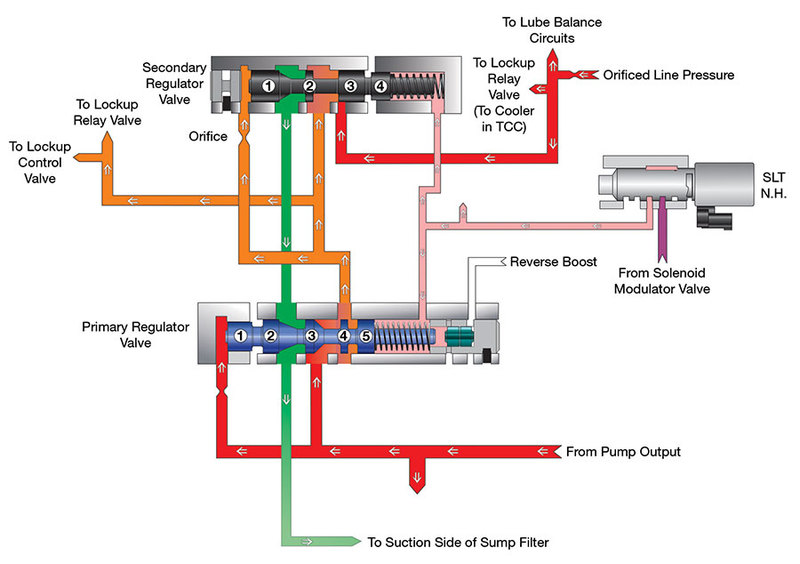 |
Pump output pressure is fed to the primary pressure regulator valve. The primary pressure regulator valve regulates this pressure through the balance feed connected to valve spool 1, the spring force, and SLT output pressure from the SLT solenoid, which acts as the pressure control solenoid on the spring side of spool 5. Regulated line pressure from the primary regulator valve is fed in between spool 3 and 4, which is connected to the secondary regulator valve between spools 2 and 3. This same feed pressure is sent to the balance side of the secondary regulator valve at spool 1. The spring force and SLT pressure at the spring side of spool 4 control secondary regulator valve pressure. Regulated pressure from the secondary regulator valve is fed to the lockup control valve and lockup relay valve. These valves control the switch from TCC Off (Figure 2) to TCC Flex to TCC On (Figure 3).
| Figure 2 – TCC Off |
|---|
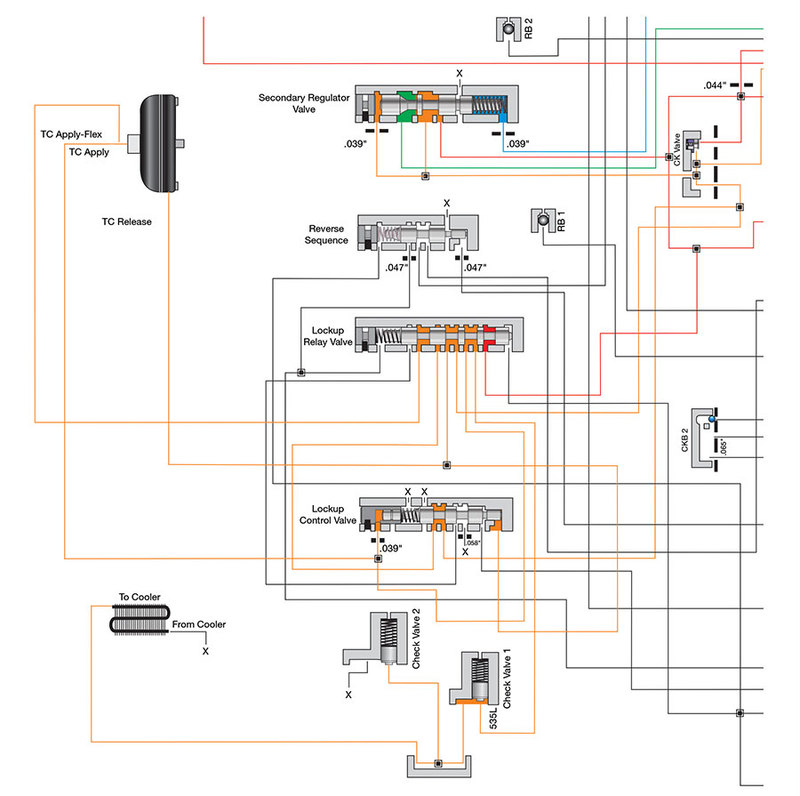 |
| Figure 3 – TCC On |
|---|
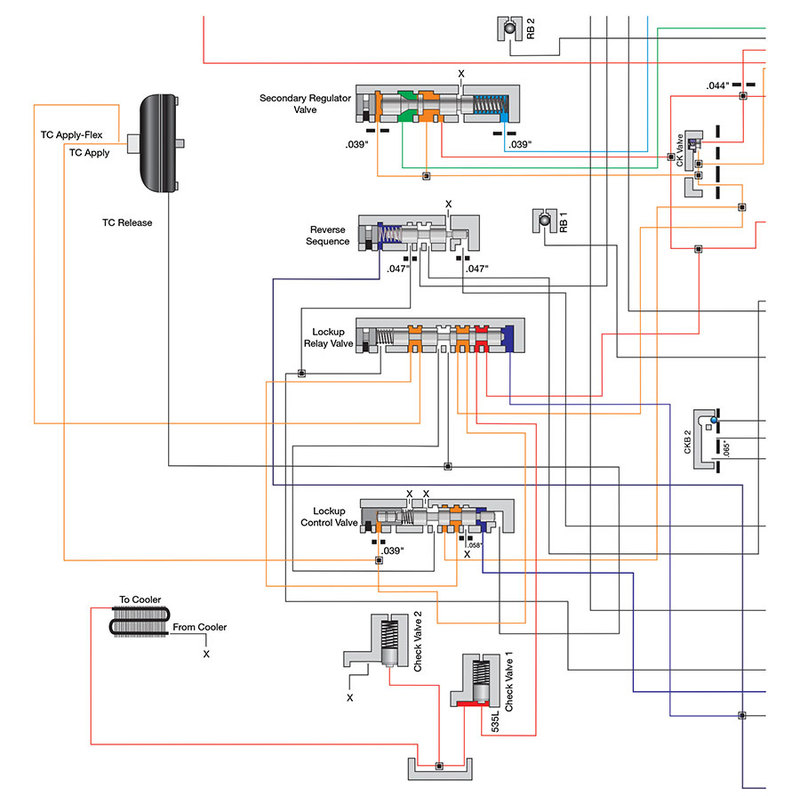 |
These are the three torque converter clutch modes available on the U760 transmission. Spool 3 of the secondary regulator valve has a connection from orificed line pressure to the internal lubrication circuits and a “To Cooler” connection that is fed to the lockup relay valve to help keep transmission fluid temperature down.
Problems in the secondary regulator valve lineup can be related to the following complaints: engine stall or stumble from the loss of TCC release pressure; torque converter slip; TCC apply chatter/shudder or no torque converter clutch application, which can create numerous diagnostic trouble codes. Lubrication and overheat issues also can stem from problems in this area.
Be sure to check out: Hydraulics Fundamentals Part IV: Converter Clutch Control Part 1
Jim Dial is a Sonnax technical specialist and a member of the Sonnax TASC Force (Technical Automotive Specialties Committee), a group of recognized industry technical specialists, transmission rebuilders and Sonnax Transmission Company technicians.
Learn More
January 28, 2019
Hydraulics Fundamentals Part I: Main Pressure Regulator Valve Line-Ups
Zachary Richardson
February 26, 2019
Hydraulics Fundamentals Part II: Accumulators & Shift Feel
Maura Stafford
March 26, 2020
Hydraulics Fundamentals Part VI: Converter Limit Valves
John Varvayanis
April 20, 2020
Hydraulics Fundamentals Part VII: AFL/Solenoid Modulator Valves
May 03, 2019
Hydraulics Fundamentals Part IV: Converter Clutch Control
Bob Warnke
June 08, 2020
Hydraulics Fundamentals Part VIII: Check Valves
March 03, 2020
Hydraulics Fundamentals Part V: Manual Valves
Jim Dial
December 17, 2020
Hydraulics Fundamentals Part X: Shift & Relay Valves
Jim Dial
Related Units
Related Parts
Required
Recommended
Required
Recommended
09G, 09K, 09M • 6F21WA • TF-60SN
Secondary Pressure Regulator Valve Kit 15741-11K
-
Helps cure:
- TCC codes
- TCC apply & release concerns
- TCC slip
- TCC surge
- Overheated fluid, bushings & converter
Required
Recommended
TF-80SC • TF-81SC
Oversized Secondary Pressure Regulator Valve Kit 39741-11K
-
Helps cure:
- TCC codes
- TCC slip
- TCC surge
- Loss of lube oil
- Overheated fluid, bushings & converter
- Poor shift quality
- Harsh Reverse
Required
Recommended
Required
Recommended
55-50SN • 55-51SN
Oversized Secondary Regulator Valve Kit 59947-16K
Also fits AF23/33 and RE5F22A units.
-
Helps cure:
- TCC slip
- TCC surge
- Overheated fluid, bushings & converter
- Poor shift quality
- Harsh Reverse
- Low lube oil flow
- Bushing failure
Required
Recommended
A340E • A340H
Oversized Secondary Pressure Regulator Valve Kit 97741-17K
Type 1 (8930 casting code)
-
Helps cure:
- TCC apply & release concerns
- Burnt TCC apply components
- Overheated transmission
- Bushing wear
Required
Recommended
A340E • A340F
Oversized Secondary Pressure Regulator Valve Kit 97741-18K
Fits '00-Later V6 & V8, late models, Type 3 & 4 valve bodies.
-
Helps cure:
- TCC apply & release concerns
- Burnt TCC apply components
- Overheated transmission
- Bushing wear
Required
Recommended
U660E • U660F • U760E • U760F
Oversized Secondary Pressure Regulator Valve Kit 47740-26K
-
Helps cure:
- TCC codes
- TCC apply & release concerns
- TCC shudder
- Lube failures
- Bearing failure
- Bushing failure
Required
Recommended
U341E • U341F
Oversized Secondary Pressure Regulator Valve Kit 37740-07K
-
Helps cure:
- Erratic TCC apply pressure
- Excess TCC slip
- Harsh TCC apply & release
- Low cooler & lube pressure
- TCC codes
While Sonnax makes every effort to ensure the accuracy of technical articles at time of publication, we assume no liability for inaccuracies or for information which may become outdated or obsolete over time.
